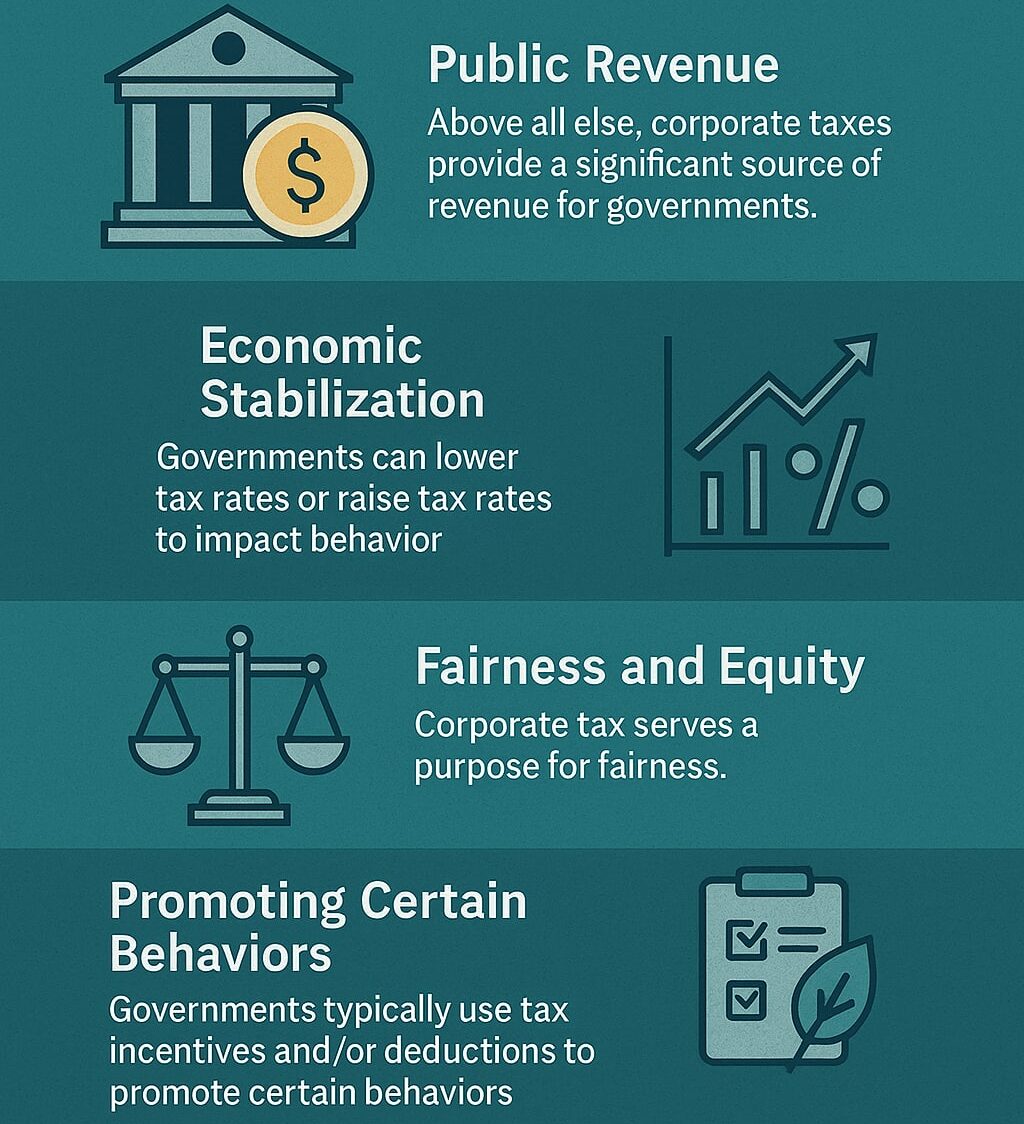Corporate Tax: Definition, Importance, and How It is Calculated
Table of Contents

Corporate tax, a government-imposed levy on company profits, is vital for fiscal policy, influencing business decisions, investment, and the economy. This guide demystifies corporate taxation for business professionals (entrepreneurs, analysts, and executives) for strategic planning and compliance; students of economics, accounting, finance, and public policy; and curious citizens interested in how governments fund services and corporations contribute to economies. It clarifies the concept, significance, and mechanics, covering types, profit calculation, tax rate impact, and global implications.
What is Corporate Tax? Understanding the Meaning & Rates
What is Corporate Tax?
Corporation tax is a direct tax that is imposed by the government on the profit of a corporation or other legal entity. Corporate tax is different from personal income tax, which is levied on individuals based on their earnings. The corporate tax is a tax imposed on a corporation’s net income, which is defined as its revenue minus its business expenses (costs of goods sold, salaries, costs of operating a business, etc.). Corporation tax raises revenue to provide public services while expecting corporations to provide their fair share of contribution to the economy.

*Finance Veda
Corporate Tax Rates
Corporate tax rates identify what percentage a business must pay on its taxable income. A corporate tax rate is not a global standardization and can vary greatly from one country to another. Here are some examples of how corporate tax rates will influence where and how companies pay tax:
- Type of company: Domestic companies will have different rates from foreign companies.
- Size or turnover of a company: Smaller companies may receive a lower tax rate with special exemptions.
- Sector: Some sectors, such as manufacturing, will receive lower tax rates as an incentive for economic growth.
- Incentives from the government: Tax rates can also be affected by government incentives or tax credits for activities such as research and development.
In addition to the fixed rate above, a company can have amounts added to its tax liability in the form of surcharges or other cesses, thus adding to the overall tax cost. Tax planning & financial management are influenced by these factors and will require that one keep these important details in mind.
Corporate Taxation: A Guide to the Tax Rate & How It's Calculated
Have you read a company’s financial report and wondered how they arrive at that final tax? While this process may seem complex, understanding corporate taxation is beneficial for any business owner, investor, or finance student. In the following guide, we’ll simplify the process for you. I will take you through the corporate tax rate and the amount of taxes owed so you can cut through the jargon and focus on the actual numbers.
Understanding the Corporate Tax Rate
The corporate tax rate is not a single number; it varies from country to country, and there are many variations based on that as well. In India, for instance, the standard rate for domestic firms is 30%, but it can fall to 25% when a company’s turnover does not exceed ₹400 crore in any given prior financial year. With investments being the government’s priority, it has also introduced the option for concessional rates of 22% and 15% for certain companies that duly comply with the specific regimes. For foreign companies with business in India, the basic corporate tax rate is significantly higher at 40%.
Besides the choice given to domestic firms, other elements of tax affect tax assessment:
Surcharge: A tax above income tax, on top of income tax, which can vary depending on the total amount of income in the relevant calculation year. For example, in India, there is a 7% surcharge for domestic companies on income over ₹1 crore but not exceeding ₹10 crore, and a 12% surcharge for income greater than ₹10 crore.
Cess: A tax that is charged for a specified and mandatory purpose. For example, for an obligatory 4% Health and Education Cess on the total assessment charged by the ‘total’ of the tax plus the surcharge.
How Corporate Tax Liabilities Are Calculated: Step-by-Step Process
The process of calculating a corporation’s final tax liability is a long one, involving a series of phases. The process begins with determining its taxable income.
Step 1 – Total Revenues and Net Profit
To start with, the corporation needs to collect all financial records to ascertain a total revenue for all income sources, such as sales, interest earned, and capital gains. Then, total revenues are reduced for all allowed expenses to calculate net profit (book profit). The allowable expenses include:
- Cost of goods sold
- Salaries and wages
- Administration and its marketing costs
- Depreciation costs on all assets
Step 2 – Identify Taxable Income
Net profit to the corporation, similar to net profit to other businesses, often does not equal taxable income. The government allows certain deductions and exemptions that may reduce the tax base. For instance, corporations often can deduct certain charitable donations or receive tax benefits for research and development investments.
The basic formula for taxable income:
Taxable Income = (Total Revenues + Other Income) – (Allowed Deductions + Exemptions)
Step 3 – Apply the Tax Rate, Surcharge, and Cess
After taxable income is assessed, a corporation takes the appropriate rate of corporate tax according to size, type, class, and any special tax regimes that may have been opted into.
Ultimately, the approach for the company’s corporate tax would include surcharges and cesses to the amount of tax calculated to quantify what the company will pay in taxes. Altogether, this calculation assures the company is complying with the tax rules and fulfilling its obligations to contribute to the economy of the country.
Corporate Tax Meaning: Defining Corporate Income Tax & Its Importance
Define Corporate Income Tax
Corporate income tax is a direct tax levied by a government agency on the profits of a corporation, and it is a tax on the company’s net income, which is the total revenues of the company subtracted by the total business expenses permitted by the tax code. Allowable business expenses will generally include costs of goods sold, wages paid to employees, and other operating costs. Although an individual pays income tax on their earned income, a corporation is treated as a separate legal entity and therefore has its profits taxed on its own. This is generally where the first level of tax on corporate profits occurs. Once a corporation has paid its corporate tax, any remaining profits can be distributed to shareholders as dividends or reinvested back into the business for growth and expansion.
The Importance of Corporate Tax
The relevance of corporate tax extends beyond revenue generation for the government, as it is a critical component of the economic policy framework and social outcomes.

Public Revenue: Above all else, corporate taxes provide a significant source of revenue for governments. This revenue is necessary to fund public services such as infrastructure, education, health, and national defense.
Economic Stabilization: Governments can lower tax rates or raise tax rates to impact behaviour in the economy. Lowering the corporate tax rate can encourage businesses to invest, create jobs, and grow, which promotes growth in the economy. Raising the corporate tax rate may assist in slowing down an overheated economy or cooling inflation.
Fairness and Equity: Corporate tax serves a purpose for fairness. Businesses benefit from public services and have a stable economy to do business in; this ups the likelihood that they pay their fair share. It is an additional level of backstop to the personal income tax system so that individuals with significant wealth who are generating profit in a corporation don’t simply funnel it through the corporation to avoid paying personal income tax.
Promoting Certain Behaviors: Governments will typically use tax incentives and/or deductions to promote certain behaviors. For example, a government could offer tax credits to companies that carry out certain research and development, hire new employees, or become green. Businesses have the opportunity to affect economic behavior and innovation.
Corporate Tax: What is It and What's the Latest Corporate Tax Rate?
What is the Current Corporate Tax Rate?
Corporate tax rates are not fixed and are at the mercy of government legislation. Corporate tax rates can also be used by the government to promote or deter various actions considered to be business activity, so it is useful to see what the situation is in a few major jurisdictions.
India
Domestic Companies: The standard corporate tax rate for domestic companies is 25%. This is effective for the Assessment Year 2024-25 onwards. There are concessional rates of 22% and even 15% for companies that choose to opt into certain tax regimes and meet the conditions of not claiming numerous exemptions and deductions. These rates are intended to stimulate new investment and economic activity.
Foreign Companies: Foreign companies operating in India are in a position where they generally face a basic tax rate of 40%, although this varies for different types of income.
USA
The Federal corporate rate is a flat 21% in the U.S. This was set by the Tax Cuts and Jobs Act (TCJA) in late 2017, when the highest rate was previously reduced from 35%. Corporations also have to consider state and local corporate income taxes, which also differ by jurisdiction. For example, Texas and Washington have no corporate income tax, but they may have a franchise tax and other considerations.
It should be noted that they are just the statutory rates. What a corporation pays is affected by other statutory taxes, such as surcharges and cess, as well as tax credits, deductions, and exemptions, so the actual tax liability may differ substantially from a static calculation based on percentages.
Discover World-Class Learning with Jaro Education
Jaro Education opens up world-class learning opportunities through collaboration with leading institutions in India and beyond. Jaro Education serves as a bridge for aspiring professionals to learn about over 250 programs from over 30 world-class universities. Jaro Education works in collaboration with some of the most prestigious institutions, such as IIMs (Indian Institutes of Management) and IITs (Indian Institutes of Technology).
Conclusion
In summary, corporate tax is much more than a mere payment of some amount; it is a basic element of any operating economy. From a corporate perspective, knowing what corporate tax means and being proficient at calculating it is integral to a project that needs financial management and planning. The tax liability of a corporation is not merely one corporate tax rate but a series of rates, surcharges, and deductions.
Frequently Asked Questions
What is the difference between corporate tax and individual income tax?
This question clarifies a fundamental point of confusion. It’s perfect for beginners or those new to the world of taxation, providing a clear distinction between the taxes paid by a business entity and those paid by a person.
How is the corporate tax rate determined for a company?
This addresses the mechanics of corporate taxation. It allows you to explain the various factors that influence the rate, such as company size, turnover, industry, and special government incentives.
What are the common deductions and exemptions for corporate tax?
This question is highly practical and valuable for business owners and accountants. You can provide examples of what a company can legally deduct from its income to reduce its tax liability, like salaries, rent, and depreciation.
Is corporate tax a direct or indirect tax?
This is a foundational concept. The answer explains that corporate tax is a direct tax, as it’s levied directly on the company’s profits, making it a good way to define the term clearly.
How does the corporate tax rate in India compare to other countries?
This is a crucial question for businesses considering international expansion or for those studying global economic policy. It allows you to provide a comparative analysis of corporate tax rates, highlighting key differences and trends.






![Top 10 Highest Paying HR Jobs in India [2025 Guide]](https://jaro-website.s3.ap-south-1.amazonaws.com/2025/10/Top-10-Highest-Paying-HR-Jobs-in-India-2025-Guide-1-1024x576.webp)











